I enter to aquarium field by raring and breeding guppy fish. They are very easy to care for and tolerate hard conditions. Untill now I have 2 or 3 guppy tanks in my collection. That’s how much I love them. Although they are easy to keep you need some guidance before setting up their tank, choosing the correct variety, and breeding. In this post, I’ll give you a full guide on “Guppy Care”.
They are one of the most famous beginner fish among aquarists. Guppy fish also are known as millions of fish and rainbow fish in some countries. The scientific name of this species is poecilia reticulata and belongs to Poeciliidae family. The first guppy specimen was sent for identification by Robert John Lechmere Guppy and was first described by Wilhelm Peters in 1859. It was named after scientist Robert John Lechmere Guppy as an honor for his contribution to the science field.
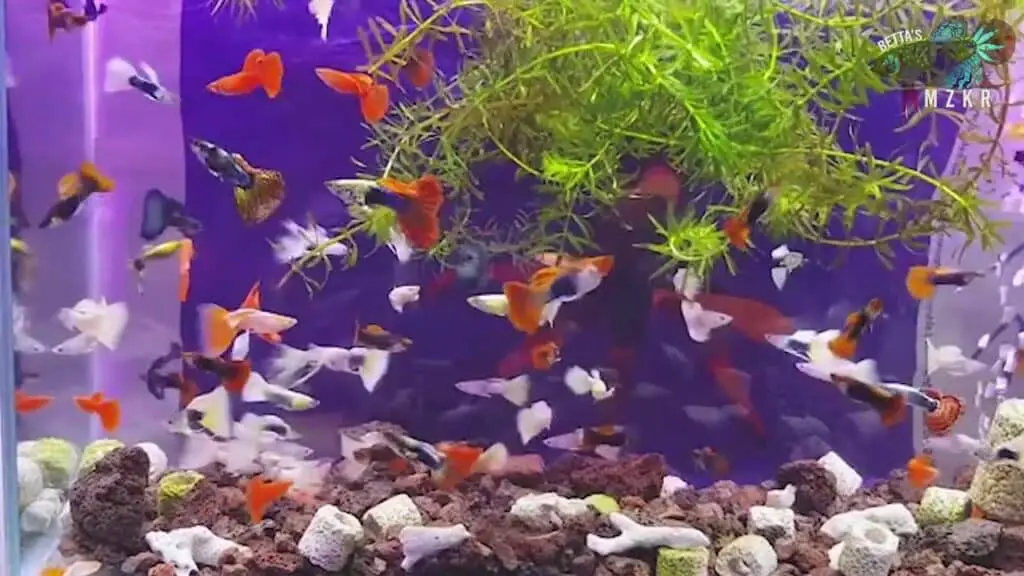
Native Distribution and Habitat
Jump To
- 1 Native Distribution and Habitat
- 2 How Long Do Guppies Live Or Guppy Lifespan?
- 3 How fast do they grow?
- 4 Identification and Guppy Fish Types
- 5 How Do You Take Care Of A Guppy?
- 6 Tank mates for guppies
- 7 Guppy feeding and Care
- 8 Guppy Fish Breeding
- 9 Care guide of the Guppy Fry
- 10 Guppy Diseases
- 11 FQA
- 12 Guppy Guide Conclusion
The birthplace of guppies is northeast South America, including Barbados, Brazil, Jamaica, Trinidad and Tobago, and Venezuela. As aquarium fish, Guppies have distributed too many parts of the world. They are tropical fish, but under controlled conditions, they can thrive well in temperate countries. They like to live in slow-moving water like small streams. Although they are freshwater species, they also can be found in brackish water environments.
| Size | 1.25 inches |
| Origin | Antigua and Barbuda, Barbados |
| Care Level | Easy |
| Temperament | 50⁰F – 84⁰F |
| Water condition | 6.8 to 7.8 pH, since this is a small tank, 10% water change must be done frequently. It usually is recommended to do a water change every 2 days—30% change weekly. |
| Compatibility | Compatible with other fish |
| Tank Setup | Set up your one-gallon tank with plants and bottoms substrate so the fish will comfort in it |
| Feeding | You can keep them on food pallets, and freeze-dried food (blood worms, brine shrimp), But make sure you do not all feed them because this is a small tank. |
| lifespan normal / in a one-gallon tank | In a large tank they will live up to three to five years, but in a one-gallon tank they leave less than one year |
| How many guppies can go in a 10-gallon tank? | Only 5, cant house a pair. (1 gallon of water can house one inch of fish ) |
| Aquarium gear | Aquarium heater, Aquarium light, aeration pump |
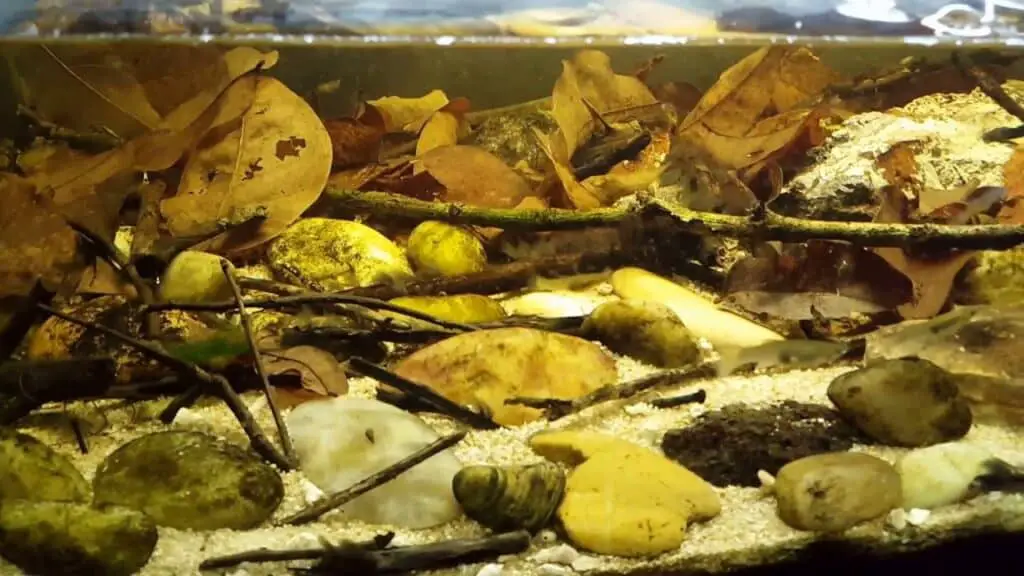
How Long Do Guppies Live Or Guppy Lifespan?
Generally, a guppy’s lifespan is around two years from birth. Female guppies mature at the age of 10-20 weeks, and males mature at the age of 7 weeks. They are very good beginner fish.
How fast do they grow?
Female guppies can reach up to 5 cm (2 inches), while male guppies can reach 3.8 cm (1.5 inches) in height. You will be able to get your guppies in full size in around 5-6 months.
Identification and Guppy Fish Types
It is very easy to identify guppies by their beautiful colors. In guppies, we can clearly identify male and female animals by their morphology. A female animal is larger, around 1.2 – 2.4 inches, and grey body color. The Male is around 0.6 – 1.4 inches with a colorful body and fin color. These fish come in all the colors you can imagine. breeders try to produce fish with novel color and dot patterns.
There first part of the body did not colorful, and the rear part, including the caudal fin, has a very eye-catching color pattern. Not only that, but some guppy is also iridescence. This means they can reflect the color from other light sources and exhibit a glowing appearance. This iridescence ability is rare among fish species. You can find different types of tails among guppies. Some of those are fantail, triangular, veil, flag tail, double swordtail, top swordtail, bottom swordtail, lyretail, needle tail, spade tail, spear tail, round tail, and Halfmoon tail.

They also have different dot patterns in their fins (cobra, grass, tuxedo, mosaic, old fashion, leopard).

How Do You Take Care Of A Guppy?
Preparing Guppy Aquarium and Care Of Guppy
Tank size requirement
Although guppies are Peaceful small fish, you may need a bigger aquarium for them. You would like to keep several Guppy in one tank. Otherwise, they would be alone and not nice to see. When there is a group of guppies swimming around, now that is something nice to see.
And there is another concern too. If you keep a small aquarium (like a 5-gallon tank), it tends to be messy and dirtier more often. And it is very hard to clean a small aquarium. After considering all these reasons, the minimum size for the guppies aquarium would be 10 gallons. You can choose smaller tanks at your own risk. So the best tank size to keep guppies is 10-gallon or 20-gallon tank. That depends on the number of guppies you house in it.
Tank preparation
The bottom of the aquarium should fill with at least 2-3 inches of gravel. This gravel layer is important for the filtering of the tank water. You should make enough hiding places for guppies in your freshwater aquariums. But do not put sharp edge objects. These are very small animals, and they can harm themselves.

Water parameters
The best water temperature range for aquariums is 23 – 27 0C (75-82 F). in this temperature range, guppies will live up to 2 -3 years. If your area’s environmental temperature is less than this range, use a heater at one end of the freshwater aquariums. Make sure to use a thermometer to monitor the temperature of the tank. In low temperatures ( lower than 23 0C), Guppies are grown slowly, and their life span increases up to 3-4 years, but they will mature later. If you keep your aquarium temperature around 27-28 0C, Guppies will grow fast and mature earlier, but their life span will decrease to 1.5 years.
Guppies’ pH levels and water hardness
guppies are hardy pets, and they can tolerate pH levels of 5.5 to 8.5 in natural environments. But it is ideal for keeping your tank’s pH in the range of 7.0 – 7.2. use a suitable meter to check your tank’s pH levels daily. The best water hardness for guppies is dGH 8-12. Also, partial water changes can help to keep the water conditions. You can decorate your tank according to your preference.
Show tank setup,
- Use gravel or sand substrate for the bottom of the tank. can select another substrate for freshwater fish.
- Use a lot of live plants to create a forest-like appearance. You can use Hornwort, an Amazon sword plant.
- Use round rocks for decoration
- You can also use deadwood
- Give some hiding places
Breeding tank setup
- No substrate at all (easy to clean)
- Only use floating plants like Java moss
Guppies typically swim around in the tank if they try to hide all the time that may be a sign of stress.
Filter setting
The filter system depends on the size of the tank. For a 10-gallon tank, it is enough to use a hang-on back filter. If your tank is too big (like 50 gallons), you have to use an external canister filter, otherwise, your tank will become dirty so often.
Tank mates for guppies
You can keep all the guppies in one tank and it is an absolutely fantastic sight. You can use different varieties of Guppies for your tank because they are community fish. Ideally, you can keep 1 Guppy in 2 gallons of water. So 10-gallons can hold 5 guppies without trouble. They can be a good addition to a community tank.
Since Guppy is non-aggressive species, you can keep them with Mollies, Gourami, Pilates, peaceful tetras, Ghost shrimp, and African dwarf frog. But do not overcrowd the tank. Keep in mind species like red-tailed sharks, Barbs, and aggressive tetras are not suitable tank mates. So keep your guppies away from them.
Guppy feeding and Care
Guppies eat both plants and small animals. Hence they are known as omnivorous and Temperament Peaceful. In a natural environment, they have plenty of fish food, and they can eat anything they want. But in aquariums, you need to feed your Guppies properly. If you need to keep the color Patten of Guppies as it is, feed guppies with specially designed quality flake food, and frozen foods. It will enhance the color of your guppies.
Other than food flakes, you can give frozen foods food like blood worms and brine shrimp. This will provide your fish food variety. Also, you can give them live food like algae, but it will deteriorate your tanks’ water quality and, therefore, is not recommended. also do not overfeed with fish flakes. You can also feed Guppy with a vegetable like peas, lettuce, and cucumber.
How Often You Should Feed
It is essential to remember Guppies are small animals, and overfeeding may cause stress. Guppies are food beggars, and with love, you may want to feed them more, but it can be deadly for them. Only feed adult guppies once or twice a day and fry 3 to 5 times a day. The amount of food should decide for you. For adult guppies, It usually is, the number of food guppies can eat within minutes or less. If there are any leftover foods, remove them quickly before giving more food. You should monitor their feeding behavior, which also indexes the health of your fish.
Guppy Fish Breeding
Of course, we can quickly breed Guppies without trouble, maybe without our interference. You can let them breed in their residence tank, or you can make a special arrangement for breeding guppies. Guppies are live-bearers, which means Guppy mothers keep their eggs inside their bellies until the eggs hatch.
Before going into Guppy breeding, decide whether you are going to keep breeding couples in the same tank or move to another tank. If you’re going to move them into another tank, make sure all the parameters in the tanks are similar. Otherwise, they will get stressed.
Guppies Males and Females
If you are going to let nature get its course, you do not have to do anything but keep an eye on them. If you want to do more than sit and watch, you can choose males and females by size, tail shape, color, or pattern in the body for breeding. You can find a full guide here on guppy male and female
You can put 2 males with one female in a breeding tank. Don’t worry, unlike other species; Guppies are not a shy species. So they will do their job perfectly sooner than later.
Read more 8 Non-Aggressive Cichlids for Community Tank And Care
It is easy it identifies males and females by Body
The female is much bigger and rounder than that a male guppy. Usually, males have very slender bodies. Females are about twice the size of males. When fully grown, males can grow up to 1-1/8 inches, and females can grow up to 2-1/8 inches. The size is noticeable early on between a male and a female Guppy.
Male Guppies are far more colorful than females. The Body of a female is normally light gray or silver, while a male’s Body is vivid with distinct patterns. Also, males have big colorful tails and tail shapes.
The anal fin of the male varies in form. Usually, a male’s anal fin is long and pointed. The female anal fin has a triangular shape. An anal fin is a fin just below the tail fin of a guppy. The gravid spot is used to identify females at an early age. It is located at the base of the tail; it is the position where the baby guppies will
develop when the guppy becomes pregnant. This dark-colored spot is unique to females and becomes more evident as the females grow older and older. It may not be easy for beginners to recognize it, but a skilled breeder will recognize a gravel spot in female fries quite early on. Look for a dark area between the abdomen and anal fin; in female baby fish, you’ll be able to find a gravid spot.
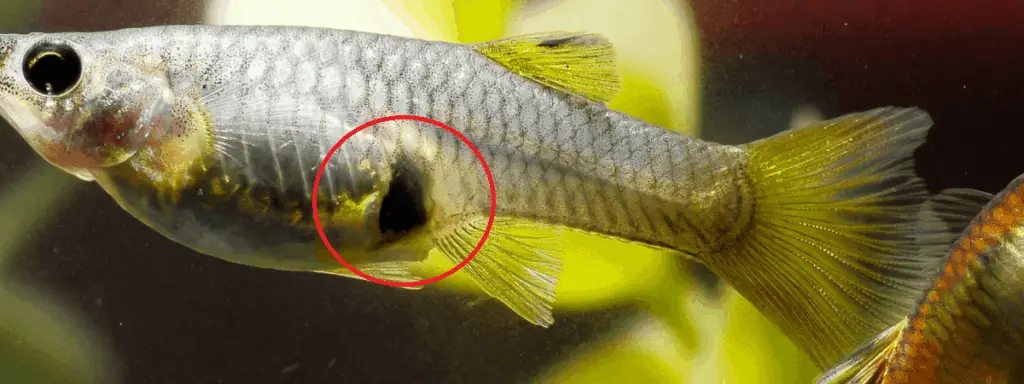
After Breeding
Since they are live-bearers, they will give birth to live animals, unlike egg-laying species. When females get pregnant, you can check easily. They will develop a dark spot at the end of the anal fin. That is where female Guppies keep their babies until they are born.
If your pregnant Guppy is in a resident tank, you can move them now into another tank until babies are born, or you can keep them in the same aquarium.
When Fry Comes Out
At this time, you may want to keep an eye on your Guppy fries. Guppy mothers sometimes eat their babies after birth. This situation is straightforward to prevent. You only have to provide enough space guppy fry to hide. If it is your typical tank when decorating, it put some live plants and makes some hiding places. If it is your separate breeding tank, add a breeding trap into your tank.
In the breeding trap, there are two sections, separated by a wall. When mother guppies lay eggs, the fry can swim into a breeding trap and safely stay there.
Condition During and After Breeding
Guppies are hardy species but Care is a must. But it is essential to keep good water quality. Otherwise, the fry will get sick. Keep a good aeration system to circulate the water and oxygenate the system.
Care guide of the Guppy Fry
Fry does not know special temperature changes, but it is better to give them a temperature between 24 – 26 0C and good water parameters. When feeding them, you have to consider their size. Fries are smaller than adult Guppies. Therefore they need to be fed smaller food particles.
You can feed them with especially med fry food or crushed larger food pellet. You can give them brine shrimp or blood worms to enhance their nutrient profile. Keep the tank as clean as possible since they are very small and susceptible to diseases. It is very wise to keep fry separately until they improve their immune system.
It will make it easy to keep an eye on these small creatures. You can spot their changes through regular monitoring. Your fry babies are ready to move into the adult tank after 6 -8 weeks. They will be mature enough to breed around 20 weeks from birth. If you are a commercial fish breeder, keep your notes on these dates.
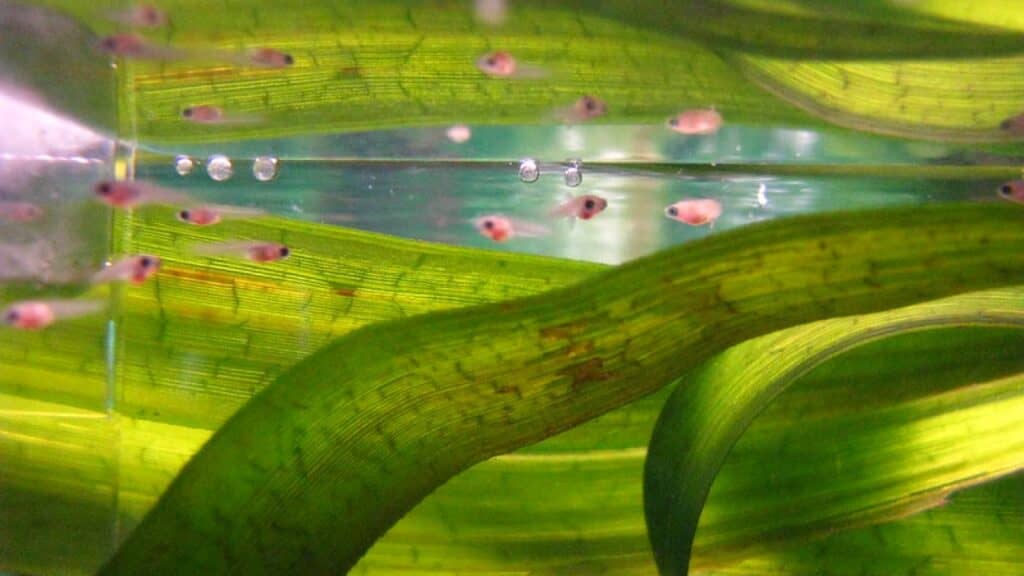
Guppy Diseases
Even though Guppies are hardy, your guppy can get a lot more diseases than you think.
White spot disease
caused by a parasite. You will see, the fish rub its body on various surfaces.
Velvet disease
this disease is characterized by tiny gold color dots in a fish body.
Fin/tail rot
there are two varieties of this disease. One is of bacterial origin; the other is of fungal origin. If fish caught fin or tail rot, the fin of the fish started to rot (damage)
Guppy disease
the causative agent for this disease is a tiny parasite. This parasite will enter to fish body via skin. Fish will show stress after infection
Columnar is and mouth fungus
although its name is a fungus, it is caused by bacteria. The disease started in the fish’s mouth or body as a big white splash. After infection, fish exhibit trouble eating and swimming. This is a highly contagious disease
Dropsy
this disease is a result of a bacterial infection. The bacteria attach to the kidney or liver of the species. As a result, the fish gut is filled with fluid. This makes the fish’s belly bigger. Infected fish exhibit trouble swimming.
Swollen gills and gasping
the disease is caused by ammonium or carbonate poisoning. The infected fish come to the water surface often to breath
Red blood spot on guppy fish
the disease is caused by ammonium or nitrites poisoning. This disease does not show any obvious marks other than small red spots on its body or belly.
Viral hemorrhagic septicemia
VHS is caused by a virus. Fish exhibit lesion’s in the body. Infectious they stop eating and become darker in color.
Popped eye
can be caused due to various reasons including polluted tank water.
And a few more diseases.
Now it is time for good news. You don’t have to worry about any of these diseases if you keep your Guppy tank clean and up to standard. Weekly and partial water changes will keep your tank water clean and disease-free.
Good working filter systems are doing a great job of preventing enter disease into the tank. And you should do your job by supplying the correct amount of food into the tank as we mentioned earlier. But any chance if your fish caught any disease, there is medicine to cure them.
FQA
How much does guppy fish cost?
At the pet stores, the guppies cost as little as $0.10 each. But if you buy fancy guppies $25. if you are a starter, you may want to invest in a good tank, filter, and fish food.
What type of water is best for guppies?
They are hardy and can live in a wide variety of water conditions. But the water must be appropriately dechlorinated. You can dechlorinate using aeration or leave it open for 24 hours. Find more information here.
Do guppies like fast-flowing water?
No. guppies like slow-moving water, which is similar to their natural habitat; creating high-flow conditions inside the home aquarium can be uncomfortable.
What fish can live with guppies in a 20-gallon tank?
They can be tank mates with all livebearer fish populations, Example – moly, and platy. Also, they can be tank mates with gurami and tetras.
What are the other names for guppies?
Guppy also known as millions of fish and rainbow fish. The scientific name of this species is poecilia reticulata
Can guppy used for mosquito control?
yes, they can. they relay love to feed on mosquito larvae. actually, they are introduced to the world as mosquito control.
Are guppies easy to take care of?
Yes, guppies are low-maintenance hardy. So they are the ideal choice if you are a new fish keeper.
Why do guppies die so quickly?
The most common reason is water quality problems. If the water is too cold, they will die. You overfeed them, which can affect the water quality, and they can die. If you can keep the proper water temperature and quality, they will live a long life.
Are guppies aggressive?
No. they are peaceful community fish. In a male-only aquarium, male guppies indicate signs of aggression. To exert supremacy, they will fight each other. If no casualties arise from the battles between the male guppies, then there is no cause for concern. If there are damages, such as tails and fins, aggressiveness is usually overcome by including females.
Why Do Guppies Chase Each Other?
When mating, guppies chase each other. It is not unusual for a guppy male to hunt a female. It’s not a sign of violence here. Whether the males outnumber the females is the only time chasing should be of concern. When males annoy her too much a female guppy may become stressed. Stressed females prefer to hide behind plants or, due to fatigue, fall to the bottom of the tank. In the aquarium, it is best to hold more females than males.
Why Guppy Floating At the Top Of Tank?
Guppies float when there is a lack of oxygen in the water at the top of the tank. When the aquarium is deep, they still swim at the top and need to rest their gills. Swimming bladder disorders in guppies can cause float at the top of the tank or fall to the bottom. Signs that a weakened swim bladder involves swimming sideways or floating upside down.
It is hungry and could come to the top of the aquarium. This could be a warning to do so if you haven’t fed them in a while. If the guppies are at the top of the tank swimming, Have they been upturned? Upturned mouths reveal that they are searching for food on the floor.
How To Tell If Guppy Is Pregnant
You can see a dark spot under the tail on the backside of the stomach when a guppy becomes pregnant. The dark spot is the gravid spot of the Guppies. Inside the mother, the gravid spot darkens and increases in size as the baby guppies mature. A pregnancy with guppies normally lasts 21-30 days.
So a female guppy will be ready to give birth within one month after mating with males. Guppy fish do not lay eggs, so live baby fish are birthed by the females.
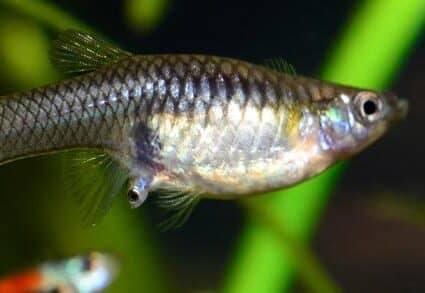
Guppy Guide Conclusion
Finally, I would like to emphasize that Guppy is an excellent choice for an aquarium due to several reasons. They come in different attractive colors and patterns. The Group of guppies swimming around is a very nice thing to look at. It is very easy to keep a guppies aquarium compared with other fish. You may need a few basic things.
While enjoying your beautiful Guppy tank, you earn some money by selling Guppy. Most importantly, Guppies are very easy to breed. You can make new varieties of guppies in several months. So keep your aquarium clean and enjoy your tank. if you like giant betta fish we also have a spot on guide
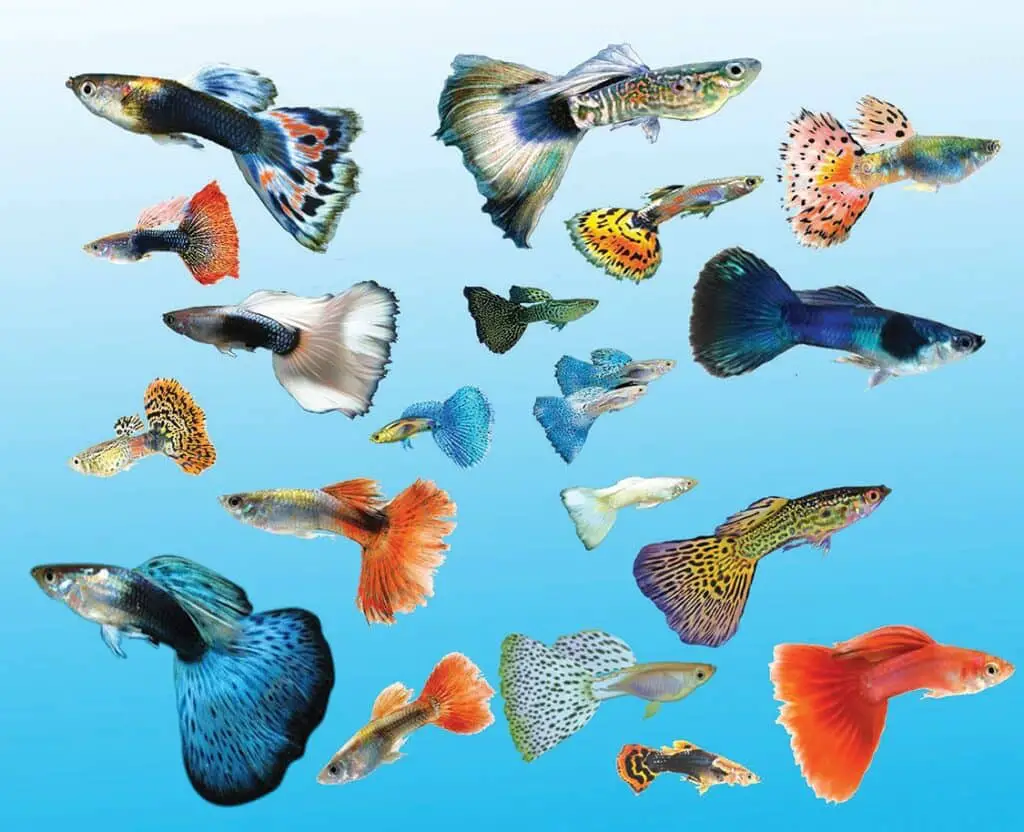
See the guide on Elephant Ear Betta
find more guides

Comments are closed.